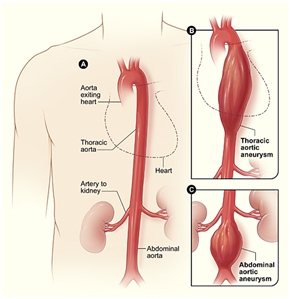An aortic aneurysm is a balloon-like bulge in the aorta, the large artery that carries blood from the heart through the chest and torso.
Aortic aneurysms work in two ways. The force of blood pumping can split the layers of the artery wall, allowing blood to leak in between them. This process is called a dissection. The aneurysm can burst completely, causing bleeding inside the body. This is called a rupture.
Dissections and ruptures are the cause of most deaths from aortic aneurysms.
On the right, Figure A shows a normal aorta. Figure B shows a thoracic aortic aneurysm located behind the heart. Figure C shows an abdominal aortic aneurysm located below the arteries that supply blood to the kidneys.
Aortic Aneurysm in the United States
- Aortic aneurysms were the primary cause of 9,863 deaths in 2014 and a contributing cause in more than 17,215 deaths in the United States in 2009.
- About two-thirds of people who have an aortic dissection are male.
- The U.S. Preventive Services Task Force recommends that men aged 65–75 years who have ever smoked should get an ultrasound screening for abdominal aortic aneurysms, even if they have no symptoms.
Types of Aortic Aneurysm
Thoracic Aortic Aneurysms
A thoracic aortic aneurysm occurs in the chest. Men and women are equally likely to get thoracic aortic aneurysms, which become more common with increasing age.
Thoracic aortic aneurysms are usually caused by high blood pressure or sudden injury. Sometimes people with inherited connective tissue disorders, such as Marfan syndrome and Ehlers-Danlos syndrome, get thoracic aortic aneurysms.
Signs and symptoms of thoracic aortic aneurysm can include:
- Sharp, sudden pain in the chest or upper back.
- Shortness of breath.
- Trouble breathing or swallowing.
Abdominal Aortic Aneurysms
An abdominal aortic aneurysm occurs below the chest. Abdominal aortic aneurysms happen more often than thoracic aortic aneurysms.
Abdominal aortic aneurysms are more common in men and among people aged 65 years and older. Abdominal aortic aneurysms are less common among blacks compared with whites.
Abdominal aortic aneurysms are usually caused by atherosclerosis (hardened arteries), but infection or injury can also cause them.
Abdominal aortic aneurysms often don’t have any symptoms. If an individual does have symptoms, they can include
- Throbbing or deep pain in your back or side.
- Pain in the buttocks, groin, or legs.
Other Types of Aneurysms
Aneurysms can occur in other parts of your body. A ruptured aneurysm in the brain can cause a stroke. Peripheral aneurysms—those found in arteries other than the aorta—can occur in the neck, in the groin, or behind the knees.
These aneurysms are less likely to rupture or dissect than aortic aneurysms, but they can form blood clots. These clots can break away and block blood flow through the artery.
Risk Factors for Aortic Aneurysm
Diseases that damage your heart and blood vessels also increase your risk for aortic aneurysm. These diseases include
- High blood pressure.
- High cholesterol.
- Atherosclerosis (hardened arteries).
- Smoking.
Some inherited connective tissue disorders, such as Marfan syndrome and Ehlers-Danlos syndrome, can also increase your risk for aortic aneurysm. Your family may also have a history of aortic aneurysms that can increase your risk.
Unhealthy behaviors can also increase your risk for aortic aneurysm, especially for people who have one of the diseases listed above. Tobacco use is the most important behavior related to aortic aneurysm. People who have a history of smoking are 3 to 5 times more likely to develop an abdominal aortic aneurys.
Treating Aortic Aneurysm
The two main treatments for aortic aneurysms are medicines and surgery. Medicines can lower blood pressure and reduce risk for an aortic aneurysm. Surgery can repair or replace the injured section of the aorta.
